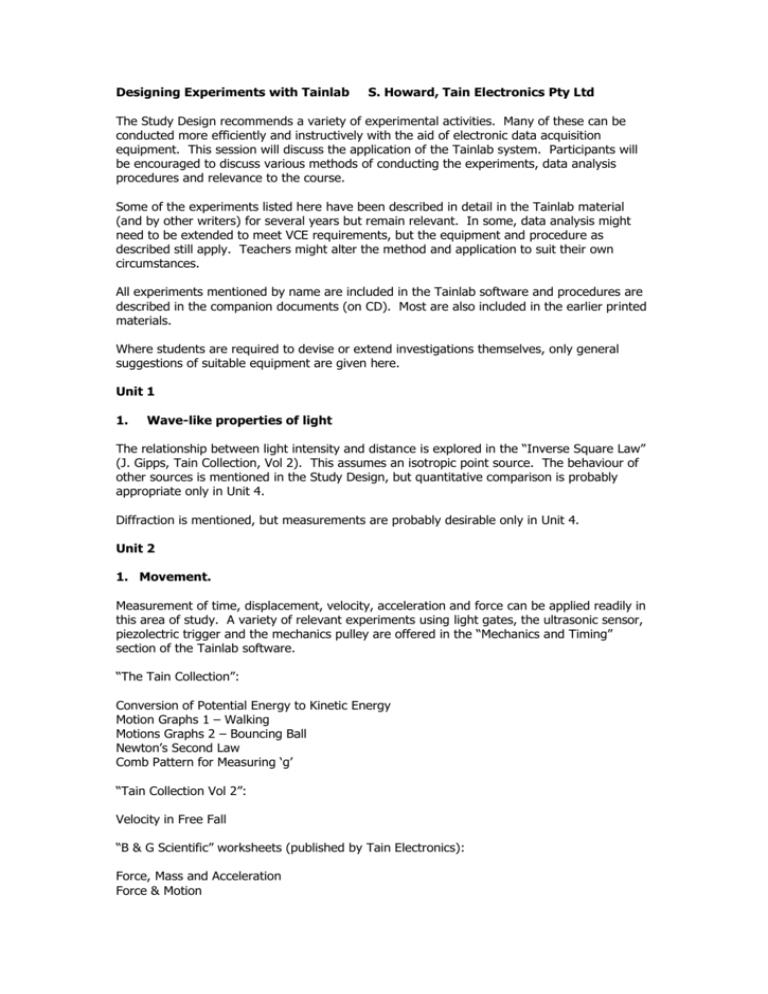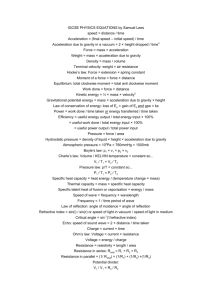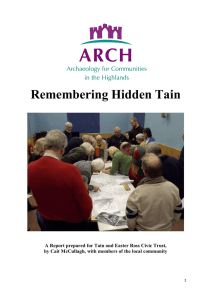Experiments for VCE Physics
advertisement

Designing Experiments with Tainlab S. Howard, Tain Electronics Pty Ltd The Study Design recommends a variety of experimental activities. Many of these can be conducted more efficiently and instructively with the aid of electronic data acquisition equipment. This session will discuss the application of the Tainlab system. Participants will be encouraged to discuss various methods of conducting the experiments, data analysis procedures and relevance to the course. Some of the experiments listed here have been described in detail in the Tainlab material (and by other writers) for several years but remain relevant. In some, data analysis might need to be extended to meet VCE requirements, but the equipment and procedure as described still apply. Teachers might alter the method and application to suit their own circumstances. All experiments mentioned by name are included in the Tainlab software and procedures are described in the companion documents (on CD). Most are also included in the earlier printed materials. Where students are required to devise or extend investigations themselves, only general suggestions of suitable equipment are given here. Unit 1 1. Wave-like properties of light The relationship between light intensity and distance is explored in the “Inverse Square Law” (J. Gipps, Tain Collection, Vol 2). This assumes an isotropic point source. The behaviour of other sources is mentioned in the Study Design, but quantitative comparison is probably appropriate only in Unit 4. Diffraction is mentioned, but measurements are probably desirable only in Unit 4. Unit 2 1. Movement. Measurement of time, displacement, velocity, acceleration and force can be applied readily in this area of study. A variety of relevant experiments using light gates, the ultrasonic sensor, piezolectric trigger and the mechanics pulley are offered in the “Mechanics and Timing” section of the Tainlab software. “The Tain Collection”: Conversion of Potential Energy to Kinetic Energy Motion Graphs 1 – Walking Motions Graphs 2 – Bouncing Ball Newton’s Second Law Comb Pattern for Measuring ‘g’ “Tain Collection Vol 2”: Velocity in Free Fall “B & G Scientific” worksheets (published by Tain Electronics): Force, Mass and Acceleration Force & Motion Terminal Speed Stopping Time Stopping Distance Stopping Force Resting on a slope Rolling down a slope The Study Design suggests measurements on playground or amusement park equipment. Few of the sensors and methods used for the familiar mechanics experiments in the laboratory are suitable. The analogue accelerometer is useful for a variety of measurements. By integration, speed can be found from acceleration and time data. 2. Electricity (Unit 2) Most of the experiments and demonstrations relevant to this area can be accomplished adequately with simple equipment such as batteries, lamps, resistors and multimeters. However, after achieving an understanding of basic circuits and measurement methods, repeated manual recording of data is slow and tedious. The immediate graphical display of current and voltage is more instructive when students are investigating the behaviour of a variety of devices. The “Electronics Panel” offers a range of experiments for Unit 2 and Unit 3. The transient measurement, “Current in a Lamp Filament” (The Tain Collection”) is directly relevant to Unit 2. Students could experiment with ways of limiting the peak current. 3. Unit 2 Detailed study 3.2 Aerospace Two experiments to introduce Bernoulli’s Principle and to described by John Gipps in “The Tain Collection, Vol. 2”. Curves” to explore the relationship between the thrust of power input to an electric motor is included on the latest demonstrate an application are A simple experiment, “Thrust/Power a propellor (an aerofoil section) and “Tainlab” CD. 3.3 Alternative Energy The Study Design requires students to devise, adapt or extend an investigation in this area. Suitable experiments could investigate the variability of energy sources (solar and wind are the most obvious) and the efficiency of energy conversion and storage. A data logger is worthwhile for many of these measurements. A variety of sensors are available for suitable experiments eg light, current, voltage and temperature. The simple procedures involved in setting these up in the “Wintec” program will be demonstrated in the session. Possible experiments are: Efficiency of secondary batteries – compare the energy required to charge a variety of battery types with the energy they deliver when discharge. Investigate the effect of charge and discharge rate on the efficiency. Similar measurement procedures to those described in detail for primary batteries in “Tain Collection, Vol 2” are applicable here. The “Power Monitor” would be preferable with larger batteries. For further data analysis, students could explore theoretically (in a spreadsheet), the benefit in applying a “DC-DC Converter” or “Stepup Converter” to recover more energy from the batteries at low voltage. Efficiency of an electric motor lifting a weight – measure for different weights Solar energy - variability with time; Efficiency of a solar panel Heating/cooling rates, thermal energy available from a solar heated “rock pile” Wind energy – variability with time Although the measurement of efficiency is an obvious one for physicists, it is not necessarily relevant in the application of “alternative” energy. For instance, a solar panel need not be the most efficient to offer cheaper electricity than its competitors. The Study Design refers to “potential for large scale implementation” in the review of a system. In this context, a photovoltaic panel would usually be evaluated primarily on the cost of its power output. How important is its area? Is its weight of any interest? Unit 3 1. Motion in one and two dimensions Data acquisition equipment offers several methods of measuring time, displacement, velocity and acceleration. Light gates, the ultrasonic sensor and the mechanics pulley, the force sensor and accelerometer are all directly applicable to activities suggested in the Study Design. Suitable experiments are: “The Tain Collection Vol 2”: Coefficient of Friction Oscillation – Mass on a Spring “B & G Scientific” worksheets Energy Stored in a Spring Circular Motion Terminal Speed The Study Design suggests experiments on crumple zones and measurement of velocity during inelastic collisions. The “Analysis of Crumple Zones” experiment on the latest Tainlab CD does this with a combination of the mechanics pulley and analogue accelerometer. When the duration of impact is very small, measurement is impractical. By experimenting with a range of designs, students can establish the inverse relationship between acceleration and time. The effect of very small impact times on the force and acceleration are then clear. 2. Electronics & Photonics The Tainlab Electronics Panel offers a variety of experiments with resistors, capacitors, diodes (incl. LEDs), temperature sensors and light sensors. Current and voltage are displayed simultaneously. To study capacitor charge and discharge, choose voltage and current as a function of time. To compare the behaviour of ohmic and non-ohmic devices, show current as a function of voltage. Experiments described in detail in the booklet supplied with the equipment are: Linear Device (Ohm’s Law) Non-Linear Devices (I-V Graphs) Voltage Dividers RC Circuits (Charging and discharging of capacitors) Input transducers Voltage Amplifiers Temperature Alarm Study of rectifiers and filter capacitors requires an oscilloscope. The computer based CRO offers the advantage of storage. For the new photonics activities, an LED oscillator circuit can be assembled on the Electronics Panel. Use a thermistor or variable resistor to control the oscillator frequency. The signal received by a phototransistor can be displayed on the computer. The frequency of the signal could be used to indicate the temperature. Circuits are included in the latest issue of the Electronics Panel booklet and on the Tainlab CD. The behaviour of an npn transistor voltage amplifier is examined in detail in the “B&G Scientific” experiments. 3.3 Further Electronics In the “Electronics Panel” experiments described above, the two involving the behaviour of diodes and capacitors are relevant again here. In a power supply, the relationship between capacitance, load and “ripple” (with full wave and half wave rectifiers) is best explored with a CRO. The Tainlab “PC Digital CRO” is adequate for this. Unit 4 1. Interactions of light and matter In the experiment “Diffraction” (by John Gipps) in “The Tain Collection Vol 2”, measurements are made with single and double slits. 2. Electric Power Suitable experiments in earlier materials are: Voltage Induced in a Coil (see “The Tain Collection”) In the original experiment intended for use at year 10, changes in the speed of the falling magnet were inferred from the shape of the voltage waveform induced in a single coil. It would also be possible to use a series of coils at several points along a pipe to indicate changes in the speed of the magnet as it fell. The method could be used with a variety of tubes. The most important comparison is between ferrous and non-ferrous metals. Magnetic Field Investigations (“The Tain Collection Vol 2”) The Study Guide suggests students investigate the efficiency of an electric motor. Motor efficiency depends on load and speed so a series of measurements should be made under a variety of conditions. Data acquisition equipment is useful in repetitive measurements like this. Using a small DC motor with reduction gearbox, record current and voltage as the motor lifts a weight; repeat for various weights. This appears on the latest “Tainlab” CD (“Electric Motor Efficiency”). 3.3 Recording and reproducing sound The “Sound Level Sensor” is “A” weighted so can be used to measure environmental noise but is not suitable for frequency response tests on loudspeakers. Use the “Sound Wave Capture” facility, either via a Tainlab interface or through the computer sound card (and Tainlab software) to display harmonics produced by musical instruments etc.









